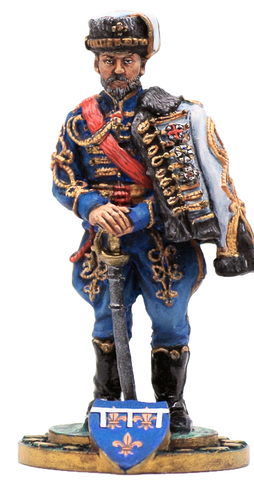
Infante Antonio
Duke of Galliera
Infante Antonio, Duke of Galliera (Antonio Maria Luis Felipe Juan Florencio de Orleans y Borbón; 23 February 1866 – 24 December 1930), was a member of the Spanish and French royal families. Antonio was the only surviving son of Prince Antoine of Orléans, Duke of Montpensier, and his wife Infanta Luisa Fernanda of Spain. Through his father, he was a grandson of King Louis Philippe of the French and his wife Princess Maria Amalia of the Two Sicilies. Through his mother, he was a grandson of King Ferdinand VII of Spain and his wife Princess Maria Christina of the Two Sicilies. Antonio was born in Seville, shortly before the end of the reign of his aunt Queen Isabella II of Spain. Due to the Glorious Revolution of 1868 which chased his family from Spain, he spent most of his childhood abroad. Yet his ambitious and liberal father Antoine, Duke of Montpensier, had some relations with the revolutionaries who forced him to flee his country of adoption. In fact, the uprising was prepared with his money and he hoped to be elected king in exchange. However, the attempt failed and the banishment of the House of Orléans was confirmed by the Spanish interim government. In 1895, King Umberto I of Italy recognised Antonio as the heir of the title Duke of Galliera. The legitimate heir of the title, Philipp la Renotière von Ferrary (1850–1917) refused to use it and Antonio brought forward his relations with the family of the last Duchess of Galliera, Maria of Brignole-Sale (1812–1888) to obtain the title.


Húsares de la Princesa. The regiment was created on March 6, 1833, with the name of Húsares de la Princesa Isabel María Luisa, daughter of Fernando VII and future Isabel II. Its quarters were located in the Royal Site of El Pardo. He receives his first banner in the Plaza de la Armería of the Royal Palace of Madrid on June 19. Its first commander was Brigadier Ramón Gómez de Bedoya, former officer of the Royal Peruvian Army. Initially used as an honorary escort for the princess, the outbreak of the civil war caused them to begin serving in the campaign along with the rest of the cavalry regiments, standing out for their heroic behavior in the taking of Orduña in 1836, in that of Peñacerrada and in the charge of Villarrobledo, also in 1836. Three actions in three years in which in each of them he received the tie of the royal and military order of San Fernando for his standard. After the war, the regiment is disbanded. It reappears in 1855 with the reorganization of the weapon and returns to the front line in the African War, distinguishing itself in the battles of Castillejos, Tetuán and Wad-Ras, all in 1860. Since then it participates in the campaigns in which the Spanish cavalry intervenes, Third Carlist War, Cuban campaigns (Spanish-American War) and Rif War.

The House of Bourbon-Orléans (French: Maison de Bourbon-Orléans) to distinguish it, is the fourth holder of Orléans surname previously used by several branches of the Royal House of France, all descended in the legitimate male line from the dynasty's founder, Hugh Capet. The house was founded by Philippe I, Duke of Orléans, younger son of Louis XIII and younger brother of Louis XIV, the "Sun King". In the Affair of the Spanish Marriages, Louis Philippe arranged for the marriage of his youngest son, Antoine, Duke of Montpensier, to Infanta Luisa Fernanda of Spain, younger sister of Isabella II of Spain. It was generally thought that she would succeed her sister as queen, since the Spanish queen's prospective husband was the effeminate Francis, Duke of Cádiz. The British wanted a prince of Saxe-Coburg-Gotha for the Spanish princess, and claimed that her future children with Montpensier would not be able to succeed to the French throne, due to the Treaty of Utrecht, wherein Montpensier's ancestor the Duke of Orleans renounced his rights to succeed to the Spanish throne for himself and his descendants. Louis Philippe opposed this interpretation and claimed that the only purpose of the Treaty of Utrecht was to keep France and Spain separate. On 10 October 1846, Montpensier married Infanta Luisa, on the same day her sister Isabella II married Cádiz. However, the
marriage of Isabella II produced many children. Montpensier funded the rebels, which helped to overthrow the government of his sister-in-law. However, the Cortes elected Amadeo of Savoy instead of him. Montpensier was later reconciled to the restored Bourbons, and his daughter married Alfonso XII of Spain, son of Isabella II. Montpensier's son, Infante Antonio, successfully claimed the succession to the dukedom of Galliera, from which this branch takes its name.
Awards: Sash and insignia of the Distinguished Order of the Golden Fleece, Stars of the Royal and Much Distinguished Order of Charles III, the Order of Montesa and the Royal Order of Saint Hubert (Bavaria).






